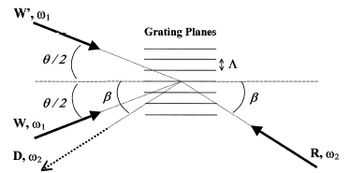Electromagnetically induced grating
Electromagnetically induced grating (EIG) is an optical interference phenomenon where an interference pattern is used to build a dynamic spatial diffraction grating in matter. EIGs are dynamically created by light interference on optically resonant materials and rely on population inversion and/or optical coherence properties of the material. They were first demonstrated with population gratings on atoms.[1] EIGs can be used for purposes of atomic/molecular velocimetry,[2] to probe the material optical properties such as coherence and population life-times,[3] and switching and routing of light.[4] Related but different effects are thermally induced gratings and photolithography gratings.
Writing, Reading and Phase matching conditions for EIG diffraction
Figure 1 shows a possible beam configuration to write and read an EIG. The period of the grating is controlled by the angle  . The writing and reading frequencies are not necessarily the same. E_B is referred as the "backward" reading beam and ER is the signal obtained by diffraction on the grating.
. The writing and reading frequencies are not necessarily the same. E_B is referred as the "backward" reading beam and ER is the signal obtained by diffraction on the grating.

The phase-matching conditions for the EIG for the plane-wave approximation is given by the simple geometric relation:
 ,
,
where the angles are given according to Fig. 2,  and
and  are the frequencies of the writing (W, W') and reading beam (R), respectively, and n is the effective index of refraction of the medium.
are the frequencies of the writing (W, W') and reading beam (R), respectively, and n is the effective index of refraction of the medium.

Types of EIG

Matter Gratings: The writing lasers form a grating by modulating density of matter or by localizing matter (trapping) on the regions of maxima (or minima) of the writing interference fields. A thermal grating is an example. Matter gratings have slow dynamics (milliseconds) compared to population and phase gratings (potentially nanoseconds and faster).
Population Gratings: The writing lasers are resonant with optical transitions in the matter and the grating is formed by optical pumping. (See Fig. 3)
Coherence Gratings: A grating where the writing lasers form a coherent matter pattern. An example is a pattern of electromagnetically induced transparency
Applications
Usually two lasers at an angle are used to build an EIG. The EIG is used to diffract a third laser, to monitor the behavior of the underlying substrate where the EIG was written or to serve as a switch for one of the lasers involved in the process.
See also
Notes
- ↑ Mitsunaga et al., Phys. Rev. A 59, 4773 (1999)
- ↑ Tabosa, J (1999). "Transient Bragg diffraction by a transferred population grating: application for cold atoms velocimetry". Optics Communications 165: 59. doi:10.1016/S0030-4018(99)00228-X.
- ↑ G.C.Cardoso, Phys. Rev. A 65, 033803 B (2002).
- ↑ Brown AW, Xiao, M, Opt. Lett. 30, 699 2005 ; Su XM, Ham BS, Dynamic control of the photonic band gap using quantum coherence Phys. Rev. A 71, 013821 (2005)
References
- Laser-induced thermal grating effects in flames, S Williams,La Rahn, Ph Paul, JW Forsman, RN Zare Opt. Lett. 19:2121, 1681–1683, 1994
- Cardoso, G. C.; Tabosa, J. (2002). "Electromagnetically induced gratings in a degenerate open two-level system". Physical Review A 65 (3): 033803. doi:10.1103/PhysRevA.65.033803.